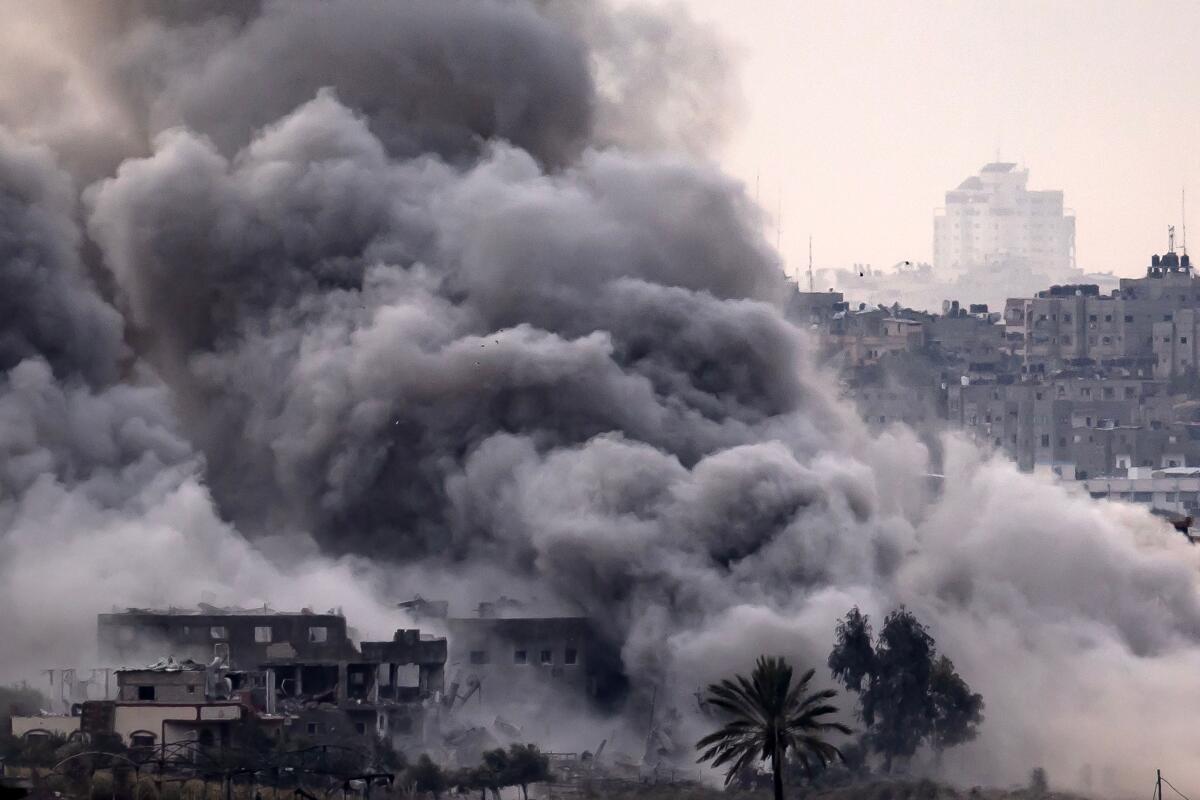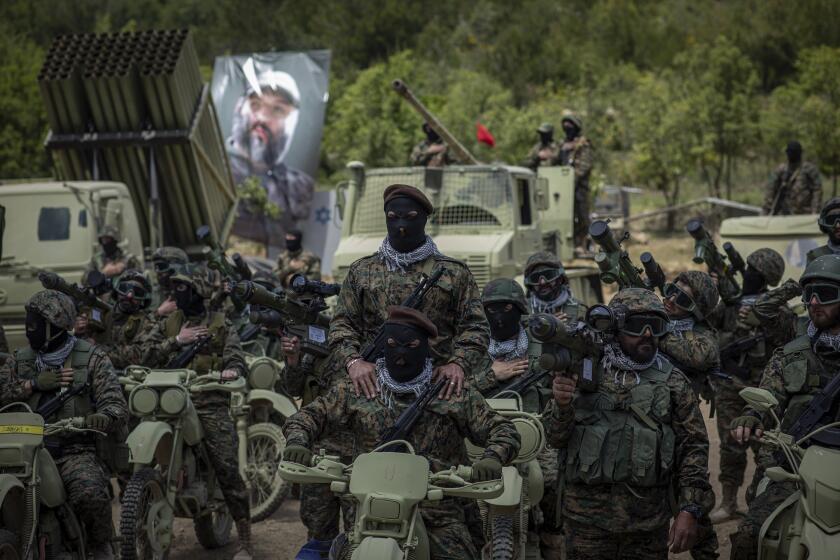Heavy fighting rages near main Gaza hospital; people inside say they cannot flee

KHAN YUNIS, Gaza Strip — Israeli ground forces on Sunday battled Hamas militants near Gaza’s largest hospital, where health officials said thousands of staff, patients and displaced people remain trapped with no electricity, dwindling supplies and some gunfire coming inside.
Prime Minister Benjamin Netanyahu has dismissed growing international calls for a cease-fire unless it includes the release of all the nearly 240 hostages kidnapped by Hamas in its bloody Oct. 7 rampage that triggered the war, saying Israel was bringing its “full force” with the aim of ending Hamas’ 16-year rule in Gaza.
Netanyahu asserted to NBC’s “Meet the Press” that Israel had offered Shifa Hospital fuel to run generators but “they refused it.”
According to Israel’s military, it placed 300 liters (about 80 gallons) of fuel near Shifa overnight for an emergency generator for incubators for premature babies and coordinated the delivery with hospital officials.
A spokesperson for the Hamas-run Gaza Health Ministry, Ashraf Qidra, told Al Jazeera that “someone contacted the director and said they have 200 liters of fuel. These 200 liters give less than an hour to run the generator. ... This is a mockery towards the patients and children.”
Residents reported heavy airstrikes and shelling, including around the hospital. Israel, without providing evidence, has accused Hamas of concealing a command post inside and under the hospital compound, allegations denied by Hamas and hospital staff.
“They are outside, not far from the gates,” said Ahmed Boursh, a resident taking shelter in the hospital.
The hospital’s last generator ran out of fuel on Saturday, leading to the deaths of three premature babies and four other patients, according to the Health Ministry. It said an additional babies are at risk of dying without electricity.
Ministry Undersecretary Munir Boursh said Israeli snipers have deployed around Shifa, firing at any movement inside the compound. He said airstrikes had destroyed several homes next to the hospital, killing three people, including a doctor.
“There are wounded in the house, and we can’t reach them,” he told Al Jazeera television. “We can’t stick our heads out of the window.”
Lebanon-based Hezbollah is holding back from all-out war with Israel for now — but chances of a dangerous miscalculation by either side are high.
Speaking to CNN, Netanyahu asserted that “100 or so” people had been evacuated from Shifa and that Israel had created safe corridors. The military said troops would assist in moving babies on Sunday, and that it was in contact with hospital staff.
But Medical Aid for Palestinians, a U.K.-based charity that has supported Shifa’s neonatal intensive care unit for years, questioned that. “The transfer of critically ill neonates is a complex and technical process,” Chief Executive Melanie Ward said in a statement. “With ambulances unable to reach the hospital ... and no hospital with capacity to receive them, there is no indication of how this can be done safely.”
It was not possible to independently ascertain the situation in and around the hospital.
The Health Ministry said there are still 1,500 patients at Shifa, along with 1,500 medical personnel and between 15,000 and 20,000 people seeking shelter.
World Health Organization Director-General Tedros Adhanom Ghebreyesus said on X, formerly Twitter, that Shifa has been without water for three days and “regrettably, the hospital is not functioning as a hospital anymore.” Several humanitarian groups told the Associated Press that they weren’t able to reach the hospital Sunday.
The president of Doctors Without Borders International, Christos Christou, told CBS’ “Face the Nation” that it would take weeks, not days, to evacuate the hospital, and the process would need to be done under a cease-fire.
The Palestinian Red Crescent rescue service said another Gaza City hospital, Al Quds, is “no longer operational” because it has run out of fuel with 6,000 people trapped there. Gaza’s sole power plant was forced to shut down a month ago, and Israel has barred any fuel imports, saying Hamas would use them for military purposes.
One woman fleeing northern Gaza, Fedaa Shangan, said she’d had a caesarean section
at Al Quds: “The wound is still fresh.” She said the Israeli army near the hospital “did not care about the presence of patients, children, women and the elderly. They did not care about anyone.”
“Decisive international action is needed now to secure an immediate humanitarian cease-fire and prevent further loss of life” amid attacks on healthcare, the U.N. regional directors of the World Health Organization and others said in a statement, adding that more than half of Gaza’s hospitals are closed and the rest are under “massive strain.”
“We do not want to see a firefight in a hospital where innocent people, helpless people, people seeking medical care are caught in the crossfire,” President Biden’s national security advisor, Jake Sullivan, told ABC’s “This Week.”
Mohamed Zaqout, director of hospitals in Gaza, said the Health Ministry has been unable to update the death toll since Friday as medics are unable to reach areas hit by Israeli bombardment. “The situation is extremely dire,” he said.
Jordanian Foreign Minister Ayman Safadi said Sunday on X, formerly Twitter, that he asked European Union foreign policy chief Josep Borrell to apply the same “legal, moral grounds” for EU support of Ukraine to “define its stand on Israel’s war crimes.”
Tens of thousands of people marched in Paris Sunday to protest rising antisemitism. And in Tel Aviv, several hundred women gathered to seek the return of hostages taken by Hamas.
The U.S. has pushed for temporary pauses in the fighting that would allow for wider distribution of badly needed aid to civilians in the besieged territory, where conditions are increasingly dire.
But Israel has agreed only to brief daily periods during which civilians can flee the area of ground combat in northern Gaza and head south on foot along two main roads. Israel continues to strike what it says are militant targets across southern Gaza, often killing women and children.
Dozens of wounded people, including children, were brought to a hospital in Khan Yunis after an Israeli airstrike demolished a building in the southern town. Hospital officials said at least 13 were killed.
The war has displaced more than two-thirds of Gaza’s 2.3-million population, with most fleeing south. Egypt has allowed hundreds of foreign passport holders and medical patients to exit through its Rafah crossing, as well as the entry of some humanitarian aid.
Wael Abu Omar, spokesperson for Gaza’s border crossings, said 846 people left Gaza to Egypt through the Rafah crossing Sunday, of which 826 were foreigners. The rest included wounded, patients from Gaza’s hospitals and their caretakers.
He said 76 aid trucks entered Gaza. The U.N. and partners have said much more needs to enter daily.
More than 11,000 Palestinians, two-thirds of them women and minors, have been killed since the war began, according to the Health Ministry in Gaza, which does not differentiate between civilian and militant deaths. About 2,700 people have been reported missing and are thought to be trapped or dead under the rubble.
At least 1,200 people have been killed on the Israeli side, mostly civilians who died in the initial Hamas attack. Forty-six Israeli soldiers have been killed in Gaza since the ground offensive began.
About 250,000 Israelis have been forced to evacuate from communities near Gaza, where Palestinian militants are still firing barrages of rockets, and along the northern border with Lebanon.
Netanyahu has said the responsibility for any harm to civilians lies with Hamas. Israel has long said the group, which operates in dense residential neighborhoods, uses civilians as human shields.
On Saturday, Netanyahu began to outline Israel’s postwar plans for Gaza, which contrast sharply with the vision put forth by the United States.
Netanyahu said that Gaza would be demilitarized and that Israel would retain the ability to enter Gaza freely to hunt down militants. He also rejected the idea that the Palestinian Authority, which currently administers parts of the Israeli-occupied West Bank, would at some stage control Gaza. Hamas drove the Palestinian Authority’s forces out of Gaza in a week of street battles in 2007.
Secretary of State Antony J. Blinken has said the U.S. opposes an Israeli reoccupation of Gaza and envisions a unified Palestinian government in both Gaza and the West Bank as a step toward a Palestinian state. Netanyahu’s government staunchly opposes Palestinian statehood.
The war threatens to trigger a wider conflict, with Israel and Hezbollah militants in Lebanon frequently trading fire along the border. Hezbollah fired antitank missiles into Israel on Sunday, and Israel responded with artillery and fighter jets. Israel’s power company said workers repairing lines damaged in previous attacks were wounded, and video showed two vehicles on fire.
The attacks wounded seven Israeli troops and 10 other people, Israel’s military and rescue services said.
The Israel Defense Forces said in a statement that “seven IDF soldiers were lightly injured as a result of the mortar shell launches in the area of Manara in northern Israel earlier today.” Israeli rescue services did not identify the location or provide information about the 10 others wounded by rocket blasts and shrapnel, but said two of them were in critical condition.
The Israeli military said it identified 15 launches from Lebanon and its defense systems intercepted four of them. The rest fell into open areas.
Hamas’ military wing, meanwhile, claimed responsibility for shelling northern Haifa and the Israeli border towns of Naura and Shlomi from southern Lebanon, without giving further details.
More to Read
Sign up for Essential California
The most important California stories and recommendations in your inbox every morning.
You may occasionally receive promotional content from the Los Angeles Times.











